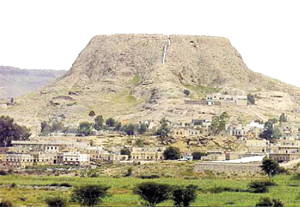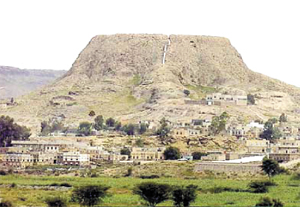
Al-DHALE’: Cynosure of tourism and remedy [Archives:2005/897/Last Page]
November 24 2005
 |
YEMEN TIMES STAFF
ESHRAQ AL-BODIGI
FOR YEMEN TIMES
Al-Dhale'a city is located to the south of the capital Sana'a, linked to it by a highway running across Dhamar governorate. The road is 250km long. It is bordered with several governorates, Dhamar on the north, the two governorates of Al-Beida'a and Abyan to the east, Lahaj to the south, and the governorates of Ibb and Taiz to the west.
Al-Dhale'a's area is about 4344 kilometers; divided into nine districts, Joban is the largest and Jahaf is the smallest one. Its relief varies between mountains plateau and valleys including fertile lands, however the mountainous characteristic is prevailing, especially in the northwest, southeast, and southwest of the governorate.
The weather is moderate and the rains pour down in summertime. The main economic activity in Al-Dhale'a depends on the seasonal agriculture. This profession is thrives in summer and spring and that also depends on floods and rainfall water that falls heavily in these two seasons.
Although this governorate is constructed as a new governorate nevertheless, it is considered one of the famous governorates of Yemen and that because of its important archeological sites and historical landmarks, which are still representing and reflecting the successive civilizations in Yemen.
Al-Dhale'a governorate has a very large civilized cultural heritage and numerous tourist historical sites and archeological milestones spread over around its districts. Some of these landmarks are effaced while others are still standing as live landmarks of the greatness of their kingdoms.
The most important archeological site in Al-Dhale'a governorate is Dei-Harran site in Al-Dhale'a province where there are some engraves that had been inscribed on stones, proved that the areas were submitted to Hameirat Empire.
Besides, there are many other historical sites discovered in certain areas of the governorate. Tahiride landmarks are still live as evidence of its magnitude in Yemen's previous eras, such as the bridge of Aamirr Bin Abdul Wahab discovered in Damt area and AL-Mansoreah school in Joban.
Not only these but also a colorful wall archeological painting that extends about 22 meters and found on a wall of AL-Nabeerah Cave at Qatabah province.
The most important archaeological and historical sites in the governorate:
Al-Dhale'a Town:
Al-Dhale'a Town is the administrative center, amid the distance on the road between Qatabah in the north and Al-Habilain in the south. The famous mountain in the area that overlooks it, is Jahaf Mountain.
Joban Town:
It is located on the road liking Qatabah to Rada'a, 55 km away from the southwest of Rada'a and 35 km far from the northeast of Qatabah Town.
Joban is one of the most important towns of the Tahiride Dynasty. In Joban there is a miniature of the Aamiriyah Mosque, also the school of Rada'a, representing an attraction place in the governorate.
Many historical features are attributed to Sultan Aamirr Bin Abdul Wahab Al-Tahiri. Among those are mosques, schools, water cisterns, channels, fortresses and walls, and the Aamiryah School and Mosque were also built in his time.
Damt Area:
It is located on the tourist way linking Yareem and Wadi Bana, runs across other tourist route beginning in Aden, and runs through, Lahaj, Al-Dhale'a, Qataban and Damt.
It is an area consists of many of many springs of mineral water where numerous visitors of this place seek for a kind of rest or remedy.
There are many other historical and archaeological sites in Hosain, Shuaib, Azariq and Hasha in Al-Dhale'a governorate.
The most famous mountains in Al-Dhale'a governorate:
– Jahaf Mountains.
– Al-Hasha chain of mountains.
– Almaan Mountain and Yarakh Mountain.
——
[archive-e:897-v:14-y:2005-d:2005-11-24-p:lastpage]


